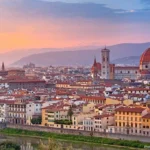
Jerusalem is estimated to be around 4,000-5,000 years old, making it one of the oldest cities in the world. Its ancient origins can be traced back to the Bronze Age, and it has been continuously inhabited throughout history. The city’s long and rich history is evident in its archaeological sites and layers of civilization that have left their mark on the landscape.
The City of Jerusalem covers a total area of around 49 square miles (126 square km). Throughout its history, the city has expanded and contracted in size, depending on various political and demographic factors. At its peak in the mid-2nd century CE, Jerusalem had a substantial population of around 200,000–300,000 residents, highlighting its prominence as a major urban center.
Jerusalem has a tumultuous history marked by destruction and rebuilding. It has been destroyed twice, first by the Babylonians in 586 BCE and later by the Romans in 70 CE. Both instances resulted in significant loss of life and cultural heritage. These destructions and subsequent reconstructions have shaped the city’s identity and left lasting impacts on its architecture and historical sites.
The construction of the First Temple, also known as Solomon’s Temple, in 957 BCE was a monumental undertaking. It required the labor of over 30,000 workers and the supervision of 7,000 individuals. The temple was a symbol of the religious and political power of ancient Jerusalem, serving as the central place of worship for the Israelites until its destruction by the Babylonians in 586 BCE.
The Second Temple, completed around 515 BCE, was a significant project that took over 20 years to construct. It was built on the same site as the First Temple and became a center of religious and cultural life in Jerusalem. The temple’s destruction by the Romans in 70 CE marked a turning point in history and the beginning of the Jewish diaspora.
Herod the Great’s expansion of the Temple Mount platform during his rule (20-10 BCE) was an engineering marvel. The massive project increased the size of the platform to approximately 35 acres and involved constructing impressive retaining walls up to 60 feet high. Herod’s architectural achievements in Jerusalem continue to awe visitors to this day.
The Temple Mount, during its peak, could accommodate over 300,000 worshippers at a time. The Western Wall, a remnant of the Second Temple, is an essential pilgrimage site for Jews. Standing at a length of 488 meters and a height of around 15 meters, it is an awe-inspiring testament to the grandeur of the former temple complex.
The Dome of the Rock, constructed between 685-691 AD on the Temple Mount, is an architectural masterpiece and one of the most important shrines in Islam. With a diameter of 36 meters, it was one of the largest religious structures of its time. Its golden dome has become an iconic symbol of Jerusalem, visible from various parts of the city.
The Al-Aqsa Mosque, believed to have been built in 705 AD, is one of the largest mosques in the world, spanning an area of 85,000 square meters. It holds great religious significance as the third holiest site in Islam. The mosque’s impressive architecture and historical importance draw millions of visitors each year.
After the destruction of the Second Temple in 70 CE, the population of Jerusalem plummeted to only 1,500 residents. The city experienced a period of decline and stagnation until it gradually grew to approximately 50,000 residents by the end of the Byzantine period in 638 CE. This population growth marked the beginning of a new era for Jerusalem and its subsequent historical developments.
Jerusalem has witnessed the rule of various civilizations throughout its history. Romans, Byzantines, Umayyads, Abbasids, Fatimids, Seljuk Turks, Crusaders, Ayyubids, Mamluks, Ottomans, British, Jordanians, and Israelis have all held dominion over the city at different periods. These successive reigns have contributed to the city’s multicultural and diverse heritage, with each civilization leaving its distinct imprint on the architecture, culture, and traditions of Jerusalem.
The Church of the Holy Sepulchre, built by Constantine the Great in 335 AD, stands as the holiest site in Christianity. It is revered as the place where Jesus was crucified, buried, and resurrected. The church’s historical and religious significance attracts pilgrims from around the world, who come to visit and pay homage to the sacred relics housed within its walls.
The Western Wall, located in Jerusalem’s Old City, holds deep religious significance for Jews. It is believed to be the last remaining part of the Second Temple’s retaining wall. The wall stretches 488 meters in length and reaches a height of approximately 15 meters, serving as a site for Jewish prayer and reflection for over two millennia.
Following the 1948 Arab-Israeli war, Jerusalem was divided, with East Jerusalem falling under Jordanian control and West Jerusalem under Israeli administration. The division was marked by the 1949 Armistice Line, commonly known as the Green Line, which separated the two sectors of the city. This division created physical and political barriers that affected the daily lives of Jerusalem’s inhabitants.
The Six-Day War in 1967 resulted in Israel’s capture of East Jerusalem from Jordanian control. Israel subsequently annexed the eastern part of the city, leading to the unification of Jerusalem under Israeli administration. The events of the Six-Day War had far-reaching implications concerning the geopolitical status of Jerusalem and the Israeli-Palestinian conflict.
Jerusalem’s Old City, spanning an area of only 0.9 square kilometers, is a UNESCO World Heritage site and encapsulates Jerusalem’s diverse religious and cultural heritage. It houses several sites sacred to Judaism, Christianity, and Islam, including the Dome of the Rock, Al-Aqsa Mosque, the Church of the Holy Sepulchre, and the Western Wall. The Old City’s narrow streets, markets, and ancient architecture provide a glimpse into the city’s historical past.
Jerusalem’s population has experienced considerable growth throughout the years. In 1961, the city had a population of approximately 181,000 residents. By 2016, the population had expanded to over 936,000 residents. This increase in population reflects the city’s significance as a cultural, political, and economic hub attracting people from different backgrounds and communities.
The City of David, situated in East Jerusalem, holds archaeological importance as one of the earliest settlements in Jerusalem. Dating back to the 11th–7th centuries BCE, it offers insights into the city’s ancient origins and the lives of its early inhabitants. Excavations in the City of David continually reveal artifacts and structures that shed light on Jerusalem’s past.
The Tower of David, originally built as a citadel in the 2nd century BCE, has played various roles throughout history. It stands 47 meters tall and contains remnants from the Second Temple period, including archaeological displays and exhibitions. Today, the Tower of David serves as a museum, providing visitors with a comprehensive understanding of the city’s historical development.
The Jerusalem light rail system, established in 2011, has become an integral part of the city’s transportation infrastructure. Its 23.5-kilometer route with 31 stations serves over 200,000 passengers daily, offering a convenient and eco-friendly mode of transportation. The light rail system has contributed to alleviating traffic congestion in the city and improving accessibility for residents and tourists alike.
Jerusalem’s Old City is home to numerous significant religious sites, cultural landmarks, and architectural wonders. Within its one-square-kilometer area, visitors can explore the rich history and heritage of Judaism, Christianity, and Islam. The Old City’s unique coexistence of diverse religious communities and the blending of different architectural styles create a captivating atmosphere that leaves a lasting impression on all who visit.
Jerusalem experiences a Mediterranean climate characterized by hot, dry summers and cool, rainy winters. The average annual rainfall in the city is around 533 millimeters, essential for sustaining vegetation and agriculture in the region. The highest recorded temperature in Jerusalem was 42.7 °C (109 °F), while the lowest temperature ever recorded plummeted to −6.7 °C (20 °F).
Jerusalem boasts a thriving higher education scene, with over 70 institutions of higher learning in the city. These institutions, including the renowned Hebrew University of Jerusalem founded in 1925, offer a wide range of academic disciplines and attract students from around the world. The city’s intellectual vibrancy contributes to its position as a global center of knowledge and research.
Some of the oldest surviving manuscripts of the Hebrew Bible originated in Jerusalem before being transported to other locations. The Aleppo Codex, for instance, was written in the 10th century CE in Jerusalem but is currently housed in Aleppo, Syria. These ancient texts provide valuable insights into the history of Judaism and the development of religious scriptures.
Jerusalem’s population density stands at approximately 6,450 people per square kilometer, making it one of the most densely populated areas in Israel. The city’s diverse community comprises various religious, ethnic, and cultural groups, living side by side and contributing to Jerusalem’s vibrant and multicultural atmosphere. The coexistence of different communities in the city is a testament to its historical and cultural significance.









